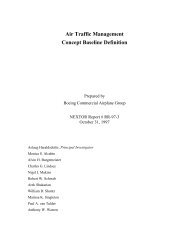Establishing an Upper-Bound for the Benefits of NextGen Trajectory ...
Establishing an Upper-Bound for the Benefits of NextGen Trajectory ...
Establishing an Upper-Bound for the Benefits of NextGen Trajectory ...
Create successful ePaper yourself
Turn your PDF publications into a flip-book with our unique Google optimized e-Paper software.
TABLE IVEXPERIMENTAL DESIGN AND EXPERIMENTAL RESULTSTotal dist<strong>an</strong>ce flown(Average dist<strong>an</strong>ce perflight)Percentage <strong>of</strong> timewith sectors aboveMAP threshold (% <strong>of</strong>time with sectors 80%or more <strong>of</strong> MAP)Number <strong>of</strong> airborneconflicts detected byATCTotal flight delays(Average delays)ScenarioGreat CircleDist<strong>an</strong>ce routes12,184,854.0nm(612.3nm)Airway routes12,783,583.0nm(642.4nm)21% (43%) 32% (44%)12,308 23,07113,444.0min (1.7min)14,076.4min (1.8min)The goal <strong>of</strong> <strong>the</strong> experiment was to evaluate <strong>the</strong> effect <strong>of</strong>introducing direct routes <strong>for</strong> domestic flights.The dist<strong>an</strong>ce flown is smaller, in average 30.1 nm, whenflights use direct routes. And <strong>the</strong> difference is statisticallysignific<strong>an</strong>t. There are more flights with routes <strong>of</strong> less th<strong>an</strong> 200nm when flight use direct routes that when <strong>the</strong>y use airwayroutes. But all <strong>the</strong> o<strong>the</strong>r route dist<strong>an</strong>ces are less frequent in <strong>the</strong>case <strong>of</strong> direct routes th<strong>an</strong> in <strong>the</strong> case <strong>of</strong> airways. This reductionin <strong>the</strong> dist<strong>an</strong>ce flown results in savings <strong>of</strong> fuel <strong>an</strong>d time.Airlines <strong>an</strong>d <strong>the</strong> environment benefit from such a reduction.Sector congestion is also reduced by using direct routesinstead <strong>of</strong> airway routes. Controllers spend 21% <strong>of</strong> <strong>the</strong>ir timem<strong>an</strong>aging overloaded sectors when <strong>the</strong> flights use direct routes,but <strong>the</strong>y spend 32% when flights use airways.Peaks <strong>of</strong> sector congestion are also more separated in time.This reduction might result in safety benefits.The total number <strong>of</strong> conflicts detected is reduced about46.7% (from 23,071 to 12,308) when using direct routes. Thisresults in safety benefits by a reduction <strong>of</strong> <strong>the</strong> workload <strong>of</strong> <strong>the</strong>controllers.Ground delays (at <strong>the</strong> origin airports) reduced when usingdirect routes, but <strong>the</strong> reduction is not signific<strong>an</strong>t. There was alimitation in <strong>the</strong> way FACET uses to assign delays that did notallow, in this experiment, to measure <strong>the</strong> airborne or arrivaldelays. The delays recorded are only due to <strong>the</strong> GDPs. And <strong>the</strong>GDPs are using maximum arrival rates <strong>for</strong> <strong>the</strong> OEP airports.This does not impose enough restrictions <strong>an</strong>d generates smalldelays.Implications <strong>of</strong> resultsThese results establish <strong>an</strong> upper bound on <strong>the</strong> benefits tobe derived by <strong>Trajectory</strong>-based Operations. The result is awin-win scenario <strong>for</strong> both <strong>the</strong> airlines <strong>an</strong>d air traffic control.The use <strong>of</strong> Great Circle Dist<strong>an</strong>ce routes geographically redistributed<strong>the</strong> flights reducing workload in <strong>the</strong> most congestedsectors <strong>an</strong>d well as signific<strong>an</strong>tly reducing conflicts in flighttrajectories. It should also be noted that <strong>the</strong> use <strong>of</strong> Great CircleDist<strong>an</strong>ce routes did not alleviate <strong>the</strong> flight delays resultingfrom over-scheduled departure <strong>an</strong>d arrivals.Future workFur<strong>the</strong>r work is required to monetize <strong>the</strong> benefits. Forexample, how does <strong>the</strong> reduction in conflicts compares to <strong>the</strong>reduction in dist<strong>an</strong>ce in terms <strong>of</strong> costs? What will be <strong>the</strong> effect<strong>of</strong> <strong>the</strong> dist<strong>an</strong>ce reduction at <strong>the</strong> destination airports, e.g. willit produce more congestion?. Also studies with more realisticinput files, i.e., including all domestic <strong>an</strong>d international flights,are required to observe congestion <strong>an</strong>d reflect <strong>the</strong> actual effect<strong>of</strong> <strong>the</strong> ch<strong>an</strong>ge. Future work also includes resolution <strong>of</strong> several<strong>an</strong>omalies in <strong>the</strong> results including: (i) great circle dist<strong>an</strong>ceroutes in excess <strong>of</strong> <strong>the</strong> associated flight pl<strong>an</strong> routes, (ii) excessiveroute dist<strong>an</strong>ce, (iii) missing flights. Detailed statistical dataare needed <strong>for</strong> <strong>the</strong> delays, e.g., st<strong>an</strong>dard deviations, modes,medi<strong>an</strong>s, <strong>an</strong>d r<strong>an</strong>ges. More studies in which <strong>the</strong> conditions<strong>of</strong> <strong>the</strong> airports are set to IFR instead <strong>of</strong> VFR will bringmore insight <strong>of</strong> <strong>the</strong> problem. The environmental effects <strong>of</strong><strong>the</strong> reduction in dist<strong>an</strong>ce must also be studied by using morespecific tools.ACKNOWLEDGMENTThe authors would like to acknowledge <strong>the</strong> contributions<strong>an</strong>d help from <strong>the</strong> following persons <strong>an</strong>d institutions.The research this study is part <strong>of</strong> is funded by NASA(NRA NNA07CN32A). Fur<strong>the</strong>rmore, Natalia Alex<strong>an</strong>drov,Kapil Sheth, María Consiglio, Bri<strong>an</strong> Baxley, <strong>an</strong>d Kurt Neitzke,all NASA employees, have provided suggestions <strong>an</strong>d commentsthroughout <strong>the</strong> whole research process.George Hunter <strong>an</strong>d Huina Gao from Sensis Corporationhave also provided suggestions <strong>an</strong>d comments through <strong>the</strong>whole research process.From George Mason University <strong>the</strong> authors would liketo acknowledge <strong>the</strong> help from Dr. Thomas Speller Jr., Dr.Kenneth De Jong, Dr. Robert Axtell, Dr. George Donohue,Dr. John Shortle, Dr. Rajesh G<strong>an</strong>es<strong>an</strong>, Maricel Medina-Mora,John Ferguson, <strong>an</strong>d Keith Sulliv<strong>an</strong>. They have all contributedto <strong>the</strong> improvement <strong>of</strong> <strong>the</strong> research in <strong>the</strong>ir particular areas <strong>of</strong>expertise.From Metro Aviation, <strong>the</strong> authors acknowledge <strong>the</strong> help <strong>an</strong>dcontribution <strong>of</strong> Jason Burke, Dr. Terry Thompson, <strong>an</strong>d NormFujisaki.From FAA, <strong>the</strong> authors acknowledge <strong>the</strong> help <strong>an</strong>d contribution<strong>of</strong> Joe Post <strong>an</strong>d Tony Di<strong>an</strong>a.Finally, th<strong>an</strong>ks to <strong>the</strong> Ministerio de Ciencia y Tecnología(Minister <strong>of</strong> Science <strong>an</strong>d Technology) <strong>of</strong> Costa Rica.REFERENCES[1] JPDO, Concept <strong>of</strong> Operations <strong>for</strong> <strong>the</strong> Next Generation Air Tr<strong>an</strong>sportationSystem, Version 2.0. Washington DC, USA: Joint Pl<strong>an</strong>ning <strong>an</strong>dDevelopment Office, June 2007.[2] A. Barnett, “Free-flight <strong>an</strong>d en route air safety: A first-order <strong>an</strong>alysis,”in Operations Research. INFORMS, Nov-Dec 2000, vol. 48, no. 6, pp.833–845. [Online]. Available: http://www.jstor.org/stable/222992[3] A. Agogino <strong>an</strong>d K. Tumer, “Regulating air traffic flow with coupledagents,” in Proceedings <strong>of</strong> 7th Int. Conf. on Autonomous Agents <strong>an</strong>dMultiagent Systems (AAMAS 2008), M. Padgham, Parkes <strong>an</strong>d Parsons,Eds., Estoril, Portugal, May 2008, pp. 535–542.[4] S. Magill, “Effect <strong>of</strong> direct routing on air traffic control capacity,” in AirTr<strong>an</strong>sportation Systems Engineering, G. L. Donohue <strong>an</strong>d A. G. Zellweger,Eds., vol. 193. USA: Americ<strong>an</strong> Institute <strong>of</strong> Aeronautics <strong>an</strong>s Astronautics,2001, pp. 385–396, iSBN 1-56347-474-3.
















